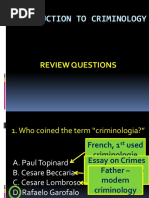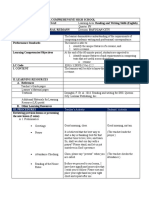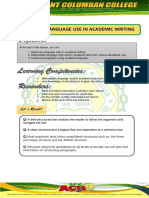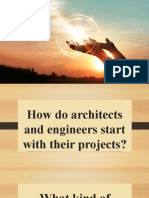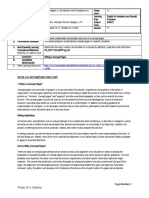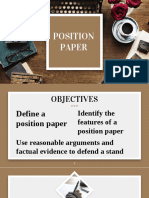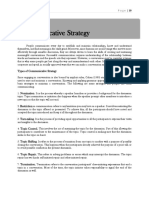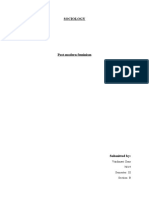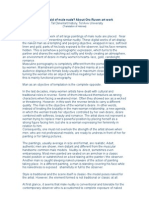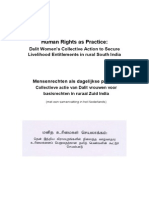EAPP WWWW
EAPP WWWW
Uploaded by
Jay-Ar MarioCopyright:
Available Formats
EAPP WWWW
EAPP WWWW
Uploaded by
Jay-Ar MarioOriginal Description:
Original Title
Copyright
Available Formats
Share this document
Did you find this document useful?
Is this content inappropriate?
Copyright:
Available Formats
EAPP WWWW
EAPP WWWW
Uploaded by
Jay-Ar MarioCopyright:
Available Formats
English for Academic and Professional Purposes
WRITING A REACTION PAPER, REVIEW AND CRITIQUE
What are Reaction Papers, Reviews, and Critiques?
A reaction paper, a review, and a critique are specialized forms of writing in which a reviewer or reader evaluates any of the following:
A scholarly work (e.g., academic books and articles)
A work of art (e.g., performance art, play, dance, sports, film, exhibits)
Designs (e.g., industrial designs, furniture, fashion design)
Graphic designs (e.g., posters, billboards, commercials, and digital media)
Reaction papers, reviews, critiques usually range in length from 250-750 words. They are not simply summaries but are critical assessments,
analyses, or evaluation of different works. As advanced forms of writing, they involve your skills in critical thinking and recognizing arguments.
However, you should connect the word critique to cynicism and pessimism.
CRITICAL APPROACHES IN WRITING A CRITIQUE
There are various ways or standpoints by which you can analyze and critique a certain material. You can critique a material based on its technical
aspects, its approach to gender, your reaction as the audience, or through its portrayal of class struggle and social structure.
1. Formalism- claims that literary works contain intrinsic properties and treats each work as a distinct work of art. In short, it posits that the key
to understanding a text is through the text itself; the historical context, the author, or any other external contexts are not necessary in interpreting
the meaning.
Following are the common aspects looked into formalism:
Author’s techniques in resolving contradictions within the work
Central passage that sums up the entirety of the work
Contribution of parts and the work as a whole to its aesthetic quality
Relationship of the form and the content
Use of imagery to develop the symbols in the work
Interconnectedness of various parts of the work
Paradox, ambiguity, and irony in the work
Unity in the work
2. Feminist Criticism-also called feminism, it focuses on how literature presents women as subjects of socio-political, psychological, and
economic oppression. It also reveals how aspects of our culture are patriarchal, i.e., how our culture views men as superior and women as inferior.
The common aspects looked into when using feminism are as follows:
How culture determines gender
How gender equality (or lack of it) is presented in the text
How gender issues are presented in literary works and other aspects of human production and daily life
How women are socially, politically, psychologically, and economically oppressed by patriarchy
How patriarchal ideology is an overpowering presence
3. Reader-Response Criticism- is concerned with the reviewer’s reaction as an audience of a work. This approach claims that the reader’s role
cannot be separated from the understanding of the work; a text does not have meaning until the reader reads it and interprets it. Readers are
therefore not passive and distant, but are active consumers of the material presented to them. The common aspects looked into when using
reader response criticism are as follows:
Interaction between the reader and the text in creating meaning
The impact of the reader’s delivery of sounds and visuals on enhancing and changing meaning
4. Marxist Criticism- is concerned with differences between economic classes and implications of a capitalist system, such as the continuing
conflicts between the working class and the elite. Hence, it attempts to reveal that the ultimate source of people’s experience is the socioeconomic
system. The common aspects looked into when using Marxist criticism are as follows:
Social class as represented in the work
Social class of the writer/creator
Social class of the characters
Conflicts and interactions between economic classes
Note that these are not the only critical approaches you can use. Other approaches in writing a critique include postmodern criticism, post-colonial
criticism, structuralism, psychological criticism, gender criticism, ecocriticism, biographical criticism, historical criticism, mythological criticism, and
deconstructionist criticism.
STRUCTURE OF A REACTION PAPER, REVIEW, OR CRITIQUE
You have to follow a logical organization and structure for your reaction paper or review to be able to present your critical evaluation effectively.
Structure for Critiques of Academic Researches and Articles
Introduction (around 5% of the paper)
o Title of the book/article/work
o Writer’s name
o Thesis Statement
Summary (Around 10% of the paper)
o Objective or purpose
o Methods used (if applicable)
o Major findings, claims, ideas, or messages
Review/Critique (in no particular order and around 75% of the paper)
o Appropriateness of methodology to support the arguments (for books and articles) or appropriateness of mode of presentation (other
works)
o Theoretical soundness, coherence of ideas
o Sufficiency and soundness of explanation in relation to other available information and experts
o Other perspectives in explaining the concepts and ideas
o It is best to ask the following questions during this part:
Does the writer explicitly state his/her thesis statement?
What are the assumptions (i.e., scientific/logical/literary explanation without evidence) mentioned in the work? Are they
explicitly discussed?
What are the contributions of the work to the field where it belongs?
What problems and issues are discussed or presented in the work?
What kinds of information (e.g., observation, survey, statistics, historical accounts) are presented in the work? How are they
used to support the arguments or thesis?
Are there other ways of supporting the arguments or thesis aside from the information used in the work? Is the author or
creator silent about these alternative ways of explanation?
Conclusion (around 10% of the paper)
o Overall impression of the work
o Scholarly or literary value of the reviewed article, book, or work
o Benefits for the intended audience or field
o Suggestion for future direction of research
For other types of reviews, there is no prescribed structure, but the following sections are almost always present.
Introduction
o Basic details about the material, such as its title, director or artist, name of exhibition/event, and the like
o Main assessment of the material (for films and performances)
Plot Summary/Description
o Gist of the plot
o Simple description of the artwork
Analysis/Interpretation
Discussion and analysis of the work (you may employ the critical approach here)
It is best to ask the following questions during this part.
o What aspects of the work make you think it is a success or failure?
o Were there unanswered questions or plot lines? If yes, how did they affect the story?
o Does the work remind you of other things you have experienced through analogies, metaphors, or other figurative
devices? How does this contribute to the meaning?
o How does the work relate to other ideas or events in the world and/or in your other studies?
o What stood out while you were watching the film or the performance?
Conclusion/Evaluation
o Reinforcement of main assessment
o Comparison to a similar work
o Recommendation of the material (if you liked it)
GUIDELINES IN WRITING A REACTION PAPER, REVIEW, OR CRITIQUE
1. For articles or journals
a. Read, view or listen to the work to be reviewed carefully to get the main topic or the concepts presented. Then revisit the work to
further identify its arguments or message.
b. Relate the content of the work to what you already know about the topic. This will make you more engaged in the article or book.
c. Focus on discussing how the book treats the topic and not the topic itself. Use phrases such as this book/work presents and the
author argues.
d. Situate your review. This means that your analysis should be anchored on the theories presented by the writer or creator.
e. Report the type of analysis or mode of presentation the writer/creator used and how this type of analysis supports the arguments and
claims.
f. Examine whether the findings are adequately supported and how the connections between ideas affect the conclusion and findings.
g. Suggest points for improvement of the reasoning, explanation, presentation of ideas, as we as alternative methods and processes of
reasoning.
h. Compare the writer’s or creator’s explanation of the topic to that of another expert from the same field of study.
i. Point out other conclusions or interpretations that the writer/creator missed out. Present other ideas that need to be examined.
j. Show your agreement with the writer’s or creator’s ideas and present an explanation for this agreement.
2. For artworks and other media
a. When critiquing artworks or posters, make sure to use speculative verbs such as evoke, create, appear, and suggest to show that
your interpretation of the artist’s work is just that- an interpretation.
b. Presume that the reader has not yet seen the material you are reviewing, so make sure to describe it to them. For reviews of films or
plays, make sure not to spoil key events unless they figure in your review, in which case always add a disclaimer.
c. For artworks, describe the material in simple terms to help your audience visualize it; refrain from being vague or abstract.
3. On a general note, your reaction paper’s conclusion may focus on the following ideas.
a. Did the work hold your interest?
b. Did the work excite or annoy you?
c. Did the work prompt you to raise questions to the author?
d. Did the work lead you to some realizations?
e. Did the work remind you of other materials that you have read, viewed or listened to in the past?
You might also like
- Karen Offen European FeminismDocument584 pagesKaren Offen European Feminismmirela.modrigala01No ratings yet
- The Routledge Companion To Gender and Science FictionDocument432 pagesThe Routledge Companion To Gender and Science Fictionleia0rganaNo ratings yet
- CHRISTINE DE PIZAN Artículo Early Feminist Theory and The Querelle Des Femmes 1400-1789Document26 pagesCHRISTINE DE PIZAN Artículo Early Feminist Theory and The Querelle Des Femmes 1400-1789Dante KlockerNo ratings yet
- Position Paper DLP PDF FreeDocument10 pagesPosition Paper DLP PDF FreeLois BornillaNo ratings yet
- EAPP DLLDocument2 pagesEAPP DLLJay-Ar Mario100% (17)
- Intro Q&ADocument83 pagesIntro Q&AGabrielnadala26100% (1)
- Smith, Andrea, Intro. Winona LaDuke - Conquest - Sexual Violence and American Indian Genocide (2015) DukeDocument263 pagesSmith, Andrea, Intro. Winona LaDuke - Conquest - Sexual Violence and American Indian Genocide (2015) DukeminorchordNo ratings yet
- Chapter 7 Writing A CritiqueDocument23 pagesChapter 7 Writing A CritiqueAbigail Ayora100% (1)
- Writing A Reaction Paper, Precis and SummaryDocument42 pagesWriting A Reaction Paper, Precis and SummaryMary Joyce Ramos100% (1)
- WEEK 5 EAAP Position PapersDocument10 pagesWEEK 5 EAAP Position PapersKreshia Kyrelle Bundal100% (1)
- LAS NO 23 Principles of Speech Delivery Audience RapportDocument2 pagesLAS NO 23 Principles of Speech Delivery Audience RapportRichard L. TiempoNo ratings yet
- Abstract, Precis, SummaryDocument13 pagesAbstract, Precis, SummaryDale Jose GarchitorenaNo ratings yet
- Review: What Are The Different TYPES of or Informal WritingDocument19 pagesReview: What Are The Different TYPES of or Informal Writingremah guingabNo ratings yet
- Reading Academic TextsDocument21 pagesReading Academic Textsdaisylabasan0% (1)
- StudylibDocument2 pagesStudylibthe.nalthisNo ratings yet
- Writing The Position Paper PPT 2Document34 pagesWriting The Position Paper PPT 2Lemonade BlinkNo ratings yet
- English For Academic and Professional Purposes - MELC AlignedDocument65 pagesEnglish For Academic and Professional Purposes - MELC AlignedMarlon Gonzales100% (1)
- EAPPDocument3 pagesEAPPANNE ESPIRITUNo ratings yet
- Summarizing ParagraphDocument10 pagesSummarizing ParagraphInayah WijayaNo ratings yet
- Eapp Cot 1Document3 pagesEapp Cot 1Melissa Rose Obido-Reponte RamilNo ratings yet
- English For Academic and Professional Purposes Module 7Document5 pagesEnglish For Academic and Professional Purposes Module 7Baby Claire Sta CruzNo ratings yet
- Concept PaperDocument16 pagesConcept PaperRochelline Rose ParaisoNo ratings yet
- Final Examination Reading and WritingDocument1 pageFinal Examination Reading and WritingLily CruzNo ratings yet
- EAPP Grade11-12 S1-2 Q1-3 LP-7Document9 pagesEAPP Grade11-12 S1-2 Q1-3 LP-7Janna Nicole Quening AlcovindasNo ratings yet
- Principles of Effective Speech Delivery in Different SituationDocument2 pagesPrinciples of Effective Speech Delivery in Different SituationJecell LasadgamNo ratings yet
- RWS - 11 - Lesson 2Document47 pagesRWS - 11 - Lesson 2Ron GruellaNo ratings yet
- EAAP Critical ApproachesDocument35 pagesEAAP Critical ApproachesJo AlabinNo ratings yet
- Objectives: Content Standards Performance StandardsDocument7 pagesObjectives: Content Standards Performance StandardsLeah Jean VillegasNo ratings yet
- Formulating Evaluative Statements FinalDocument50 pagesFormulating Evaluative Statements FinalAngelyn LingatongNo ratings yet
- RWS - 11 - Lesson 4Document10 pagesRWS - 11 - Lesson 4Ron GruellaNo ratings yet
- Eapp Lesson 6 Facts and OpinionDocument23 pagesEapp Lesson 6 Facts and OpinionAnonymous B6Zc9h02d5No ratings yet
- Tudela National Comprehensive High SchoolDocument18 pagesTudela National Comprehensive High SchoolLilani Gonzaga Boco ElmedulanNo ratings yet
- 3 Evaluating Sources PDFDocument18 pages3 Evaluating Sources PDFGozon EliNo ratings yet
- Position PaperDocument21 pagesPosition PaperDivina Grace Rodriguez - LibreaNo ratings yet
- English12 English For Academic and Professional Purposes Q1 Week1 Tiu Juliza S. Dacanay Lorlaine RDocument13 pagesEnglish12 English For Academic and Professional Purposes Q1 Week1 Tiu Juliza S. Dacanay Lorlaine RELSA CALUNODNo ratings yet
- Definition of Speech ActsDocument7 pagesDefinition of Speech ActsWiljon Bermas Odi100% (1)
- Creating Thesis Statements PDFDocument5 pagesCreating Thesis Statements PDFLouiegie B. MendozaNo ratings yet
- Patterns of Paragraph DevelopmentDocument7 pagesPatterns of Paragraph DevelopmentDeathkillNo ratings yet
- Hypertext and IntertextDocument2 pagesHypertext and IntertextJorbin Alcala100% (1)
- Patterns of Development and Properties of Well-Written TextsDocument3 pagesPatterns of Development and Properties of Well-Written TextsMerry RosalNo ratings yet
- Positioning P He in Four Discourse QuadrantsDocument21 pagesPositioning P He in Four Discourse QuadrantsFrances Ian Clima100% (1)
- Exam in EAPP 2019Document2 pagesExam in EAPP 2019Sumugat TricyNo ratings yet
- EAPP Module 8Document23 pagesEAPP Module 8RO BieNo ratings yet
- Eapp ReviewerDocument7 pagesEapp ReviewerELOISA DELOS SANTOSNo ratings yet
- GR 11 Stem 9 Marangal Pr1 Manuscript Group 4 LabandiloDocument16 pagesGR 11 Stem 9 Marangal Pr1 Manuscript Group 4 LabandiloBianca Ysabel BascoNo ratings yet
- Summative Test Eapp Week1&2Document3 pagesSummative Test Eapp Week1&2AbbegailPearl AguirreNo ratings yet
- Academic Text Reading Skills of Senior High School Students of Batangas CityDocument9 pagesAcademic Text Reading Skills of Senior High School Students of Batangas CityElkissa Joy Lumbres Yutuc100% (1)
- Lesson 2:: Language Use in Academic WritingDocument10 pagesLesson 2:: Language Use in Academic WritingAAAAA100% (1)
- Compare and Contrast Variouskinds of Concept PapersDocument13 pagesCompare and Contrast Variouskinds of Concept PapersKazuya 2302100% (1)
- Writing A Concept PaperDocument31 pagesWriting A Concept PaperDhaine Louis De Villa75% (4)
- Day 3.3 and 3.4 PREPARING BIBLIOGRAPHIES AND OUTLINESDocument56 pagesDay 3.3 and 3.4 PREPARING BIBLIOGRAPHIES AND OUTLINESChristine Anne ClementeNo ratings yet
- EAPP Module 6 and 7Document16 pagesEAPP Module 6 and 7Ma. Khulyn AlvarezNo ratings yet
- Paper Review 1Document4 pagesPaper Review 1Min BeshNo ratings yet
- Reading and Writing (Prelim)Document4 pagesReading and Writing (Prelim)rica jean barroquilloNo ratings yet
- EFAPP LAS 7 (AutoRecovered)Document11 pagesEFAPP LAS 7 (AutoRecovered)Daniel Angelo Esquejo ArangoNo ratings yet
- Writing A Concept PaperDocument15 pagesWriting A Concept PaperINQI SubjectNo ratings yet
- EAPP Critique PaperDocument10 pagesEAPP Critique PaperPerlyn Del Pilar OduyaNo ratings yet
- Position PaperDocument63 pagesPosition PaperToni Joy AgaoNo ratings yet
- EAPP Reflection Week2Document1 pageEAPP Reflection Week2Phoebe Rafunsel Sumbongan JuyadNo ratings yet
- Lesson 5 OUTLINE READING TEXTS IN VARIOUS DISCIPLINESDocument13 pagesLesson 5 OUTLINE READING TEXTS IN VARIOUS DISCIPLINESjolinamarizNo ratings yet
- Q4 SHS Reading and WritingDocument4 pagesQ4 SHS Reading and WritingLeonilo C. Dumaguing Jr.No ratings yet
- Types of Speeches Oral CommDocument5 pagesTypes of Speeches Oral Commنجشو گحوشNo ratings yet
- The Problem and Its Background: San Jose - Litex Senior High SchoolDocument57 pagesThe Problem and Its Background: San Jose - Litex Senior High School13- DOCOG MA. ANGELICANo ratings yet
- Walkthrough-English For Academic and Professional Purposes - QTR 1 - WengDSLDocument52 pagesWalkthrough-English For Academic and Professional Purposes - QTR 1 - WengDSLMarissa Dulay - Sitanos100% (1)
- Pre-Test: Critical Reading Critical ThinkingDocument26 pagesPre-Test: Critical Reading Critical Thinkingairene germanNo ratings yet
- Republic of The Philippines Region 1: Division of La Union Upper Tumapoc National High SchoolDocument1 pageRepublic of The Philippines Region 1: Division of La Union Upper Tumapoc National High SchoolJay-Ar MarioNo ratings yet
- Upper Tumapoc National High School: Student'S HandbookDocument11 pagesUpper Tumapoc National High School: Student'S HandbookJay-Ar MarioNo ratings yet
- FINAL EXAM - For MergeDocument6 pagesFINAL EXAM - For MergeJay-Ar MarioNo ratings yet
- Upper Tumapoc National High School: Student'S HandbookDocument11 pagesUpper Tumapoc National High School: Student'S HandbookJay-Ar MarioNo ratings yet
- PERIODICAL TEST 2nd Garding Quantitative For PrintingDocument6 pagesPERIODICAL TEST 2nd Garding Quantitative For PrintingJay-Ar MarioNo ratings yet
- PERIODICAL TEST 2nd Garding Quantitative For PrintingDocument6 pagesPERIODICAL TEST 2nd Garding Quantitative For PrintingJay-Ar MarioNo ratings yet
- Business Interactive Reward Coin Makes Interaction ValuableDocument2 pagesBusiness Interactive Reward Coin Makes Interaction ValuableJay-Ar MarioNo ratings yet
- ICTDocument3 pagesICTJay-Ar MarioNo ratings yet
- UscpDocument33 pagesUscpJay-Ar MarioNo ratings yet
- DRRM QuizDocument1 pageDRRM QuizJay-Ar Mario67% (9)
- Grade 7 Exam 3Document4 pagesGrade 7 Exam 3Jay-Ar MarioNo ratings yet
- BUDGET of WORK in English For Academic and Professional PurposesDocument6 pagesBUDGET of WORK in English For Academic and Professional PurposesJay-Ar MarioNo ratings yet
- Adr ReportDocument7 pagesAdr ReportJay-Ar MarioNo ratings yet
- Diversity Difference and Caribbean Feminism - The Challenge of Anti RacismDocument24 pagesDiversity Difference and Caribbean Feminism - The Challenge of Anti RacismNuratifah NabilahNo ratings yet
- The Problem With Pussy PowerDocument56 pagesThe Problem With Pussy PowerWill JamesNo ratings yet
- Love and Violence - Gender Paradoxes in Volatile Attachments PDFDocument14 pagesLove and Violence - Gender Paradoxes in Volatile Attachments PDFjoseignacio182No ratings yet
- Post Modern FeminismDocument12 pagesPost Modern FeminismSiddhuNo ratings yet
- Feminism in India - A Changing Perspective: F I I: A C P 'Document21 pagesFeminism in India - A Changing Perspective: F I I: A C P 'Shubhankar ThakurNo ratings yet
- Feminist Film Theory and CriticismDocument21 pagesFeminist Film Theory and CriticismKlykkeNo ratings yet
- Schreiber - Righting FeminismDocument54 pagesSchreiber - Righting FeminismLola BorgesNo ratings yet
- What Are Some of The Key Differences Between Second-Wave and Third-Wave Feminisms?Document4 pagesWhat Are Some of The Key Differences Between Second-Wave and Third-Wave Feminisms?YICAN LINo ratings yet
- Sociology ProjectDocument20 pagesSociology ProjectBhanupratap Singh Shekhawat0% (1)
- Instant download Language and Gender An Advanced Resource Book Routledge Applied Linguistics 1st Edition J. Sunderland pdf all chapterDocument45 pagesInstant download Language and Gender An Advanced Resource Book Routledge Applied Linguistics 1st Edition J. Sunderland pdf all chapterchovysilmon60No ratings yet
- An Introduction To Political Theory - O - P - Gauba - 1981 - Macmillan - Anna's ArchiveDocument592 pagesAn Introduction To Political Theory - O - P - Gauba - 1981 - Macmillan - Anna's ArchiveLov KrNo ratings yet
- CAT 2020 Slot 3 Question Paper by CrackuDocument82 pagesCAT 2020 Slot 3 Question Paper by CrackuShambhavi TrivediNo ratings yet
- Encyclopedia of Social History PDFDocument1,195 pagesEncyclopedia of Social History PDFAndrijaNo ratings yet
- Gen Soc Reviewer MidtermDocument9 pagesGen Soc Reviewer MidtermNU EvahNo ratings yet
- Who's Afraid of Male Nude - DR DekelDocument3 pagesWho's Afraid of Male Nude - DR DekelOra Ruven100% (1)
- MangubhaiDocument211 pagesMangubhaiVaishnavi JayakumarNo ratings yet
- The Legacy of Sarah Grand's The Heavenly Twins: A Review EssayDocument14 pagesThe Legacy of Sarah Grand's The Heavenly Twins: A Review Essaybob robNo ratings yet
- Class 10 Civics Chapter 4 Gender, Religion and Caste NotesDocument10 pagesClass 10 Civics Chapter 4 Gender, Religion and Caste NotesrazaNo ratings yet
- Women Torture Spectacle On Chilean TelevisionDocument14 pagesWomen Torture Spectacle On Chilean TelevisionMaca Yunge GonzalezNo ratings yet
- BBA 407 GUIDE BOOK Smu 4rth SemDocument81 pagesBBA 407 GUIDE BOOK Smu 4rth SemlalsinghNo ratings yet
- Aunt Jennifer's Tigers: The Real Meaning Behind The Poem: Poetic Analysis EssayDocument3 pagesAunt Jennifer's Tigers: The Real Meaning Behind The Poem: Poetic Analysis EssayJonah Cortezzo50% (2)
- Instant download Gendered Voices, Feminist Visions: Classic and Contemporary Readings 7th Edition Susan M. Shaw pdf all chapterDocument47 pagesInstant download Gendered Voices, Feminist Visions: Classic and Contemporary Readings 7th Edition Susan M. Shaw pdf all chapterohegyibrghol100% (1)
- Stereoes: IN Modern SocietyDocument314 pagesStereoes: IN Modern SocietyRita Pavone100% (1)
- Give Her Another Hundred YearsDocument2 pagesGive Her Another Hundred YearsGianluca MoebiusNo ratings yet
- DiplomaExamQuestions PDFDocument21 pagesDiplomaExamQuestions PDFAnonymous dLIq7U3DKzNo ratings yet






